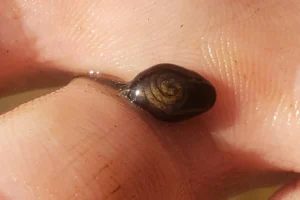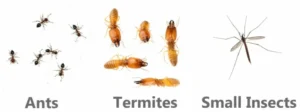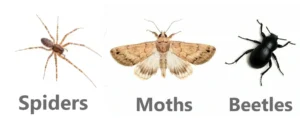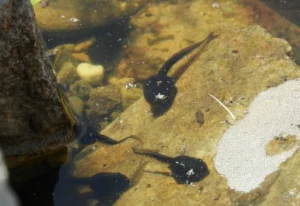The American toad (Anaxyrus americanus) is a common species of toad found throughout Canada and the eastern United States. Like most other toads, American toads are obligate carnivores as adults, which means they only eat animal-based and do not eat plants.
American toads are generalist predators and will eat almost any prey they can catch, overpower, and fit into their mouths. In the wild, they eat snails, slugs, earthworms, ants, spiders, a wide variety of insects, and other invertebrates. In captivity, they can be fed crickets, dubia roaches, nightcrawlers, mealworms, and other invertebrates.
American toads develop in two main life stages. They start their lives as tiny tadpoles that live entirely in the water. At this stage, they eat algae, plant tissue, and detritus in their aquatic environments.
After about 40 to 70 days, these tadpoles will through a process known as metamorphosis and develop into the adult form American toads that most people are more familiar with
At this point, they become obligate carnivores and will eat a wide variety of prey they can catch. A single American toad can eat up to 1,000 insects every day!
What American Toad Tadpoles Eat in the Wild
American toads start their lives as tiny embryos inside eggs. Their first food source for the developing embryos is the yolk of their eggs.
The yolk provides enough nutrition to sustain the developing tadpoles until they are ready to hatch into the water. This can take anywhere from 3 to 12 days.
After hatching, the tadpoles will have poorly developed gills, mouths, and tails – so they can not properly swim or eat yet.
For this reason, they will spend the first few days feeding on the remaining yolk of the eggs. This will provide them with enough energy to grow and develop further.

After about a few days, the tadpoles would have developed enough to start free swimming and feeding on food sources available in the water.
At this early stage, American toad tadpoles are almost completely herbivorous, and will eat:
- Algae
- Soft roots and leaves of aquatic plants (eg. duckweed mosses)
- Phytoplankton
- Detritus (mostly composed of degraded plant materials)
Due to a mostly herbivorous diet, the tadpoles have very long tightly coiled intestines, that make up more than half of their body mass.

Plants contain cellulose, a compound that is very hard to digest. Because of this, plant matter needs to spend more time in the digestive system. This long intestinal tract gives tadpoles more time to break down the plant matter and absorb as many nutrients as possible.
American Toad Tadpoles Become Omnivores
A few weeks into their development, the tadpoles start to grow legs, starting with the back legs. Their digestive tract will also gradually shorten.
American toad tadpoles at this stage become omnivores and will eat animal protein in addition to plant matter.
They will also eat:
- Aquatic insect larvae (glass worms, mosquito larvae, etc)
- Water striders
- Zooplankton
- Small insects that fall into the water
- Worms
- Carcasses in the water
Whatever they eat, they will eat constantly. They have high energy demands because they are growing very rapidly. Growing big as fast as possible is necessary for survival, as they are at the mercy of environmental conditions.
What Juvenile American Toads Eat in the Wild
After about 50 – 60 days, the tadpoles will go through a process known as metamorphosis, in which they will transform into juvenile toads
During metamorphosis, the thyroid gland secretes a growth hormone called thyroxine.
This hormone triggers the tadpoles to:
- Lose the gills, and develop lungs for breathing air
- Absorb the tail into the body
- Grow strong legs for moving on land
- Remodel other organs to form an adult toad
In addition, the digestive tract shortens dramatically, and the inner lining of the remaining intestine thickens, creating many folds in the process. These folds create a very large surface for the absorption of nutrients during digestion.
Once metamorphosis fully is complete, tiny toadlets will leave the water and live on land
At this point, American toads become obligate carnivores, which means they stop eating plant matter and will only eat animal-based foods.

However, since they are not fully grown yet, they can only eat small live prey.
Wild Juvenile American toads will eat:
- Ants
- Mites
- Small worms
- Small snails, slugs
- Spiders
- Termites
- Springtails
- Crane flies
- Fruit flies, and other small insects
As they grow in size, they will be able to eat larger prey.
What Adult American Toads Eat in the Wild
Adult American toads are fully grown, meaning they have bigger mouths and stronger jaws. They basically eat a larger version of the diet they did as juveniles, but their larger size also allows them to eat things they did not eat as juveniles.

Like the juveniles, adult American toads generally prefer to eat live prey and will almost not eat dead bugs or other dead prey items.
Here’s a list of things that make up an adult American toads diet in the wild:
- Worms, grubs, slugs, snails
- Beetles, stinkbugs, wasps, bees, grasshoppers, cockroaches,
- Spiders, centipedes, millipedes
- Mosquitos, termites, ants, mites, springtails
- Mosquitoes, fruit flies, crane flies, crickets
- Moths, butterflies, and a wide variety of other insects
Adult American toads are generalist carnivores and will eat just about anything they can fit in their mouths. During spring and summer nights, they often catch and eat insects as they fall to the ground under outdoor lights.
Unlike most toads, who wait for prey to come along and pounce on it, American toads can shoot out their sticky tongues to catch prey.
They also may use their front legs in order to eat larger food. They grasp their food and push it into their mouths.
Although these toads are primarily crepuscular, they will search for food during late afternoons, as the weather gets cooler.
They are very voracious eaters – as earlier mentioned, one American toad can eat up to 1,000 insects every day.
What Adult American Toads Eat In Captivity
Captive American toads can eat all the food they would eat in the wild. The only reason they have a different diet is that most hobbyists cannot easily obtain the wide variety of prey these frogs eat in the wild.
So they are limited to only prey items they can purchase or culture on their own.

However, even in captivity, American toads have to be fed live prey. These live prey items can be purchased in a pet store, online, or even from another hobbyist.
Alternatively, you could culture feeder insects at home if you are up for the challenge.
Here’s a list of things you can feed an American toad in captivity:
- Crickets, dubia roaches, orange head roaches
- Wingless fruit flies, nightcrawlers
- Mealworms, waxworms, Super worms,
- Phoenix Worms, black soldier fly larvae
- Silkworms, hornworms
American toads are not picky eaters, and will readily accept most soft-bodied invertebrates.
The key to a proper diet for captive toads is variety. Crickets and Dubia roaches can make up their diet. However, it is essential that they are supplemented with a good variety of other prey items such as nightcrawlers, silkworms, hornworms, etc.
Be careful to feed the proper size prey for your toads’ size. A good rule of thumb is that a cricket should never be larger than the distance between the toad’s eyes, or the distance from its eyes to its nose.
Also, IT IS NOT RECOMMENDED to feed red wigglers (Eisenia fetida) to captive amphibians. This is because they exude a noxious fluid that contains a toxin known as Lysenin – which is poisonous to many animals.
When feeding insects with a hard exoskeleton to your pet (such as mealworms or super worms), try to make sure the insects have recently molted, as an insect with a large, hard exoskeleton is difficult to digest and may cause impaction.
As for fruit flies, I recommend Hydei fruit flies as they are considerably bigger than the Melanogaster fruit flies and make a richer meal for your toad.
Can You Feed a Captive American Toad Wild Bugs?
You could feed your American toad wild-caught bugs. Just be 100% sure they are from a clean area that’s free of pesticides or other chemicals. Avoid feeding bugs that can sting or bite, such as large spiders, hornets, bees, etc.
However, it is generally not a good idea to feed captive toads wild bugs or other wild prey. This is because wild insects may carry diseases and parasites that your toad is vulnerable to.
Also, wild bugs in a seemingly clean area could be carrying pesticides they picked up from another area.
Gut-Loading & Nutrient Supplements
Captive-bred feeder insects are often raised on a cost-conscious diet that is meant to help them grow quickly. This means they are not as nutritious as wild insects that eat a wide variety of vitamin and mineral-rich food.
If your toad is given a low-nutrient diet, it could develop health problems such as metabolic bone disease – which is a fairly common issue in captive amphibians.
For this reason, it is important to increase the nutritional value of the food you give to your toad.
This is mainly done in two ways: dusting, and gut loading.
Gut Loading
Gut loading is the process by which feeder insects are fed nutrient-dense foods at least 48 hrs before they are offered to the toad. The intention is to pass those nutrients on to the toad when the insects are eaten.
The process is simple
- Give your feeder insects nutrient-dense foods, such as fresh vegetables with lots of vitamin C.
- After eating this food, the feeder insects will be much more nutritious and pass the nutrients on to the toad when they are eaten.
Dusting
Besides gut loading, another way to ensure your frog gets all the vitamins and minerals it needs is by dusting its food with high-quality powder calcium and vitamin supplements.
Most hobbyists use commercially manufactured supplement powder specifically designed for reptiles and amphibians.
The process is simple:
- First, add a small pinch of supplement powder into a small container such as a cup or an empty cereal container. The powder should only be enough to lightly dust the insects.
- Place one feeding’s worth of feeder insects in the container
- Gently shake the container so the supplements lightly coat the insects
- Once finished, you can offer the dusted insects to your toad.
It is a good idea to consult a veterinarian for specific directions on supplementing your pet’s food since many variables go into determining the best supplementation regimen for each animal.
Following your veterinarian’s instructions could help you avoid over-supplementing food.
Otherwise, a good starting point is to dust with a good quality calcium supplement fortified with vitamin D3, 2-3 times a week.
How Much & How Often to Feed Your American Toad
Generally, adult American toads will have to be fed every two or three days, while young toads will need to be fed every day or two.
However, this is not set in stone. If an adult does not eat much during feeding sessions, they may have to be fed every other day.
In addition, the enclosure’s temperature will determine the feeding frequency.
If the temperature is low, your American toad will have a slower metabolism and be less active, so it won’t need to each much.
At warmer temperatures, your toad will have a much faster metabolism and will need to be fed much more frequently (every other day).
Regarding how much to feed your American toad, the general rule is to only offer as much as the toad can eat in a 20-minute feeding session.
American toads love to eat! Be careful to not overfeed your toad. Use personal judgment to ensure most of the food offered is being consumed.
Keep a close eye on the toad so you can adjust their diet accordingly. If your toad is becoming overweight, consider reducing the number of food items you feed them each meal.
Likewise, if they’re underweight – you need to feed them more food items per feeding or feed them more times per week.
How Long Can American Toads Go Without Food?
Generally, healthy adult American toads can go for as long as two weeks without food if the environmental temperatures are low, and the toads have a reduced rate of metabolism.
Juvenile American toads can not survive long without food as they are still growing and have higher energy needs.
However, this isn’t to say you should test the endurance of your toad.
In most situations, it’s a good idea to offer food to your American toad at least two-three times per week.
What American Toad Tadpoles Eat In Captivity
American toad tadpoles have a different diet from metamorphosed adults. During the first few days after they hatch, they will absorb the remaining yolk around them so feeding won’t be necessary.

Once the tadpoles begin moving around and free swimming, you can start feeding them boiled and finely chopped vegetables such as:
- Lettuce
- Broccoli
- Baby spinach
- Zucchini
Apart from vegetables, you can also feed:
- Algae wafers
- Plant-based fish flakes (for herbivorous fish)
- Aquatic frog and tadpole food
When the tadpoles start to grow legs and lose their tails, you can start feeding them late-stage tadpole food, as well as fish flakes for omnivorous fish.
Finely grind the fish flakes in a blender – until you get a fine powder. You may have to sift the ground food through a small wire mesh sieve to remove larger pieces.
Like the adults and juveniles, American toad tadpoles benefit from a varied diet so it’s important to rotate their diet. You can use both vegetables and commercial food to give greater variety.
What Juvenile (Baby) American Toads Eat In Captivity
When the tadpoles go through metamorphosis (in about 50 – 60 days) and transform into toadlets, they become obligate carnivores – so they have to be fed small live prey.
Since they are not fully grown yet, they have to be fed a smaller version of their adult diet. The food has to be gut-loaded and dusted with supplements.
American toad toadlets can be fed:
- Pinhead crickets
- Wingless fruit flies
- Springtails
- Small mealworms
As the toadlets grow in size, they will be able to eat larger things.
The toadlets have huge appetites so they have to be fed every day – and as a general rule, their food should be dusted more often than an adult’s.
Be careful to feed the proper size prey for your toadlets’ size.
As earlier mentioned, a good rule of thumb is that a cricket should never be larger than the distance between the toad’s eyes, or the distance from its eyes to its nose.
What Human Foods Can American Toads Eat?
Toadlets and adult American toads are obligate carnivores and are instinctively attracted to movement while hunting for food. For this reason, they will not eat the vast majority of human food.
Humans do not typically eat live food and tend to cook most of their food, so human food will not even register as food to most toads, including American toads. If you try to offer human food to an American toad, it will not eat it and will go hungry
How to Feed an American Toad in Captivity
The most straightforward way to feed a toad is to simply dump the food into its enclosure and let the frog have its fill.
However, some amphibian owners find it easier and safer to feed their pet in a separate enclosure, free of bedding and furniture.
This way you can be sure your toad eats all its insects, the prey cannot hide, and the toad will not pick up any bedding when grabbing prey and mistakenly ingest it along with the prey.
Some toads, especially those that are still getting used to a new place may be shy and reluctant to eat. In this case, you could entice the toad to eat with the use of some feeding tongs.
Use the tongs to gently hold the food item, then rub it near the nose of the toad. Once he sees it, he will grab it and eat it.
Common Feeding Mistakes
There are a few common mistakes many new toad owners make when feeding their pets.
Using Dead Bugs
In the wild, frogs and toads are ambush hunters that are attracted to prey by movement (motion). For this reason, American toads won’t eat dead bugs. If you offer your American toad dead bugs, it will most likely ignore the food and starve. You should only offer live bugs and other prey items.
Using the Wrong-Sized Feeder Insects
Toads do not chew their food but rather swallow it whole. Feeding a tiny toad a disproportionately large insect could lead it to choke.
Never give a toad anything larger than the distance between its eyes. The bigger the toad, the larger the prey it will be able to eat.
Forgetting to Gut Load Insects
As mentioned earlier, captive-bred feeder insects do not contain as many nutrients as wild insects. They are often raised on a cost-conscious diet that is aimed at making them grow quickly and keeping costs low.
Forgetting to gut load or dust insects before feeding them to your American toad means the frog will not get all the nutrients it needs. This nutritional deficiency can lead to serious health problems, and could even be fatal.
Not Using a Varied Diet
Different food items have different nutrients. Not giving an American toad a varied diet means it will not get the right variety of nutrients it needs and may end up weak and malnourished.
Switch up the food items offered to the toad every few feedings so it gets a nutrient-rich diet.
Feeding Food With a High-Fat Content Too Often
Captive amphibians are not very active animals, so they do not burn off calories. This means giving a captive American toad high-fat food (such as wax worms) too often may lead to obesity.
Obesity can then lead to many health problems. For this reason, it is important to limit food with a high-fat content to only an occasional treat.
Overfeeding/ Underfeeding
Overfeeding a toad can lead to obesity, which could lead to several health problems. Alternatively, underfeeding means the toad will be undernourished and have poor health.
Why Isn’t My American Toad Eating?
1. It Is Still Getting Used to a New Place or Is Shy
The most common reason a toad won’t eat is that it is under stress, or still getting used to a new place. This is a very common problem with newly acquired toads.
To remedy this, try hand-feeding the toad with the help of feeding tongs/tweezers. Use the tongs to gently hold the prey item, and wiggle it in front of the toad to entice it to eat.
If this does not work try moving the toad to a dark room, and leave it alone to relax and settle down for a while. In the wild, American toads are primarily crepuscular creatures, so they will be more active in the dark and twilight hours.
2. You Are Feeding the Frog at the Wrong Time of the Day
Despite being crepuscular, American toads can usually eat at any time of the day. However, sometimes individual toads may have their own feeding preferences.
If your American toad won’t eat during the day, try feeding it just before the lights turn off in its enclosure. Or, If you’re not using a UVB light, during the evening time as the sun is going down.
3. The Prey Item Being Offered Is Too Big
Another reason an American toad may reject food is that the prey item you are offering is just too big. Remember, toad do not chew their food, so they will not eat anything they can now swallow whole.
As a general rule, never offer a toad any prey larger than the distance between its eyes.
4. It Is Not Accustomed to the Food Item Being Offered
Another possible reason a toad may reject food is that it is not used to eating the food you are offering. Try switching the food item being offered. Most American toads will readily accept live crickets, dubia roaches, and other soft-bodied invertebrates.
5. The Environmental Temperatures Are Low
Remember, toads are ectothermic (cold-blooded animals). When the temperatures are low, they will have a lower rate of metabolism, and be less active, so they won’t have the biggest appetite.
This is perfectly normal, and the toad will have a much better appetite when the temperatures are warmer.
Common Questions About American Toad Diet
Can American toads eat worms?
In the wild, American toads will eat any worms they can catch – and In captivity, they will readily accept live earthworms. They are instinctively attracted to movement when hunting for food, so they will not eat dead worms.
Can American toads eat fruit?
American toads are obligate carnivores as adults and do not eat fruit or any other plants. Their digestive systems are suited for digesting animal-based foods, rather than plants matter.
What do American toad tadpoles eat?
Green tree frog tadpoles are mostly herbivorous and eat algae, the soft roots, and leaves of aquatic plants, plankton, and detritus. As the tadpoles grow, they become omnivorous and will eat aquatic insects, carcasses in the water, and other animal-based foods.
What do baby American toads eat?
American toads start as tadpoles that eat algae, soft plants, and small invertebrates. Over time, the tadpoles will transform into baby gray tree frogs that are obligate carnivores. Once transformed, baby American toads will eat ants, mites, termites, mosquitoes, and other small insects.
Featured image credit: Andy Reago & Chrissy McClarren (CC BY 2.0).
Sources
Virginia Herpetological Society. Eastern American Toad Anaxyrus americanus americanus. Accessed at: https://www.virginiaherpetologicalsociety.com/amphibians/frogsandtoads/eastern-American-toad/index.php
Grossman, S. 2002. “Anaxyrus americanus” (On-line), Animal Diversity Web. Accessed at: https://animaldiversity.org/accounts/Anaxyrus_americanus
Canadian Herpetological Society. American Toad Anaxyrus americanus. Accessed at: https://canadianherpetology.ca/species/species_page.html?cname=American Toad
The Savannah River Ecology Laboratory (SREL). American Toad (Bufo [Anaxyrus] americanus). Accessed at: https://srelherp.uga.edu/anurans/bufame.htm


